comet
Latest
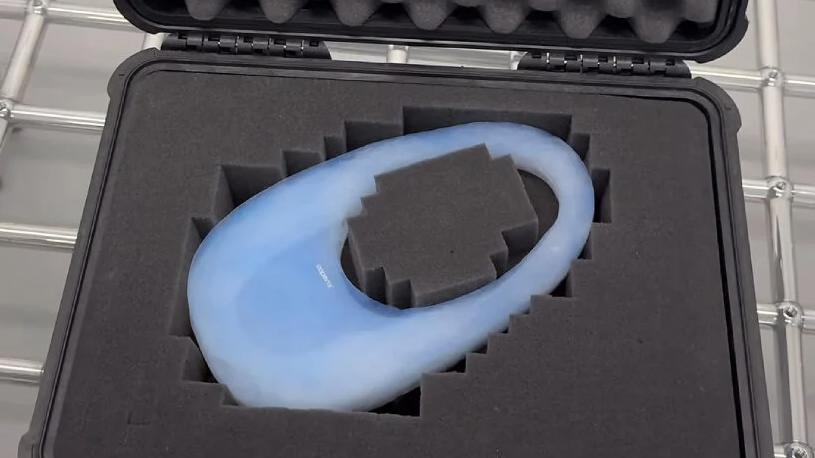
This luxury handbag is made from the material NASA uses to collect comet dust
Luxury brand Coperni has created a small bag made of nanomaterial silica aerogel — previously used by NASA to collect comet dust.

James Webb telescope finds water around a comet in the main asteroid belt
The James Webb telescope has spotted the first known instance of a comet with water vapor in the main asteroid belt.

Hubble telescope spots the largest known comet to date
Scientists using the Hubble Space Telescope have detected the largest known comet to date — it's about 50 times larger than usual
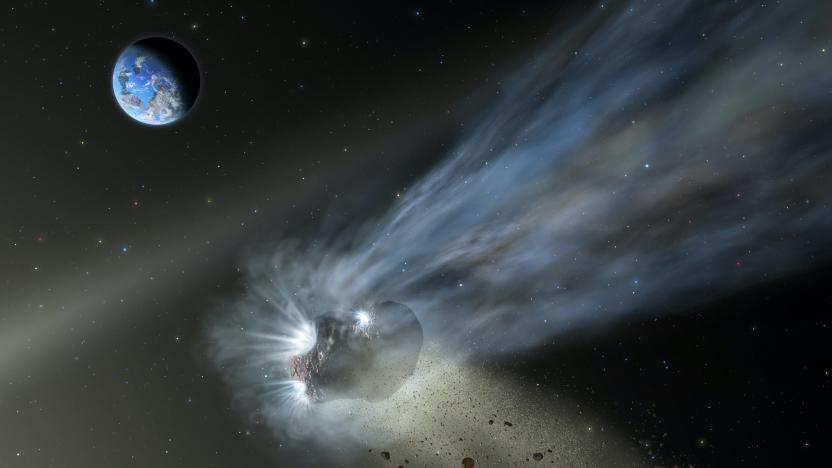
Comets may have seeded Earth with life-supporting carbon
A snapshot of a comet carrying carbon as it zipped past Earth in 2016 is helping NASA learn more about the origins of life.

European astronauts plan to take pics of a comet from the dawn of time
The European Space Agency (ESA) hopes to photograph a yet-to-be-discovered comet as it approaches Earth's orbit for the first time. To do so, it's developing "Comet Interceptor," a composite made of three individual spacecraft, which will separate to snap photos of the comet from multiple perspectives. The photos will be used to create a 3D model, and ESA hopes to spot material from the dawn of the Solar System.

Strange interstellar object 'Oumuamua is tiny and very reflective
After no small amount of mystery, we're starting to understand more about 'Oumuamua, the first known interstellar object to visit the Solar System. A newly published study indicates that the object can't be that large, for one thing. As the Spitzer Space Telescope's infrared detection couldn't catch the cigar-shaped entity, that makes it relatively small. It's likely less than half a mile (2,600 feet) at its longest. It also can't have a diameter larger than 1,440 feet, and that figure could be as small as 320 feet.
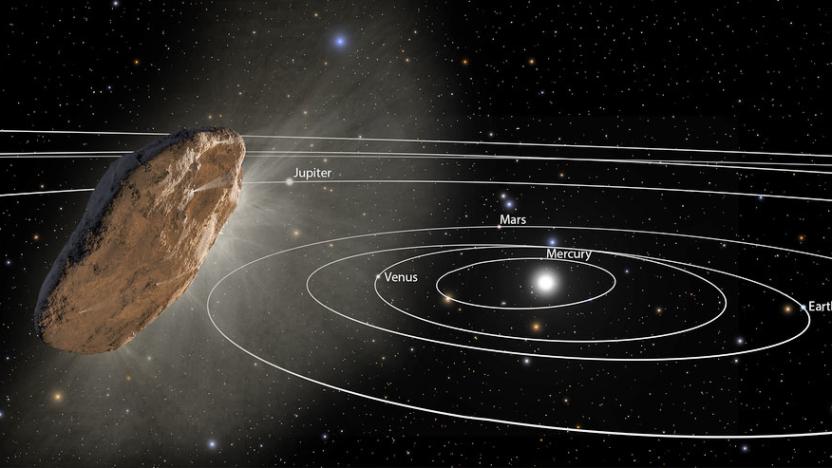
Turns out the interstellar object ‘Oumuamua is a comet after all
Last October, researchers spotted a long, skinny object speeding through our solar system, and they initially pegged it as a comet from another solar system. But as they continued to observe the object, dubbed 'Oumuamua, its properties -- namely a lack of gas and dust surrounding it -- pushed it into the asteroid category, instead. Asteroids are mostly rock, while comets contain ice that becomes visible as it's vaporized into gas and pulls dust off of the comet's surface. However, researchers have kept their telescopes pointed at 'Oumuamua and additional observations have now earned the object a comet label once again.

First observed interstellar object is a speedy, cigar-shaped asteroid
Last month, astronomers running the Pan-STARRS 1 telescope in Hawaii spotted an intriguing object moving through our solar system and it became clear pretty quickly that the object, whether it was a comet or an asteroid, had come from outside of our solar system. Now, in a paper published this week in the journal Nature, researchers have described the interstellar visitor, dubbed 'Oumuamua, including its peculiarities as well as its similarities to objects originating in our own solar system.

Researchers observe the first known interstellar comet
To date, every comet humanity has seen inside the Solar System has come from the Solar System, whether it's the Kuiper Belt or the billions of comets believed to make up the Oort Cloud. Now, however, it looks like astronomers might have found a comet of interstellar origin. They've used Hawaii's Pan-STARRS 1 telescope to track C/2017 U1, an object with a very eccentric, hyperbolic orbit (that is, moving quickly enough to escape gravitational pull) that wasn't connected to the Sun. The trajectory suggests that it's a comet which escaped from a nearby star, rather than something knocked out a familiar path and drawn in by the Sun's gravity.

NASA seeks comet 'crumbs' with a new detection technique
It's relatively trivial to spot comets, but spotting the dust they leave behind? That's no mean feat -- it's like tracking grains of fast-moving sand on a cosmic-scale beach. NASA, however, might just have a way of mapping that dust. It's developing a technique that would use the movement of the ESA's LISA Pathfinder probe to detect the minuscule "crumbs" left by comets and asteroids. The trick involves tracking the tiny thruster bursts Pathfinder uses to compensate for dust stream impacts. When you measure the direction and strength of those bursts, you can get a good sense of the dust's impact location, size and trajectory.
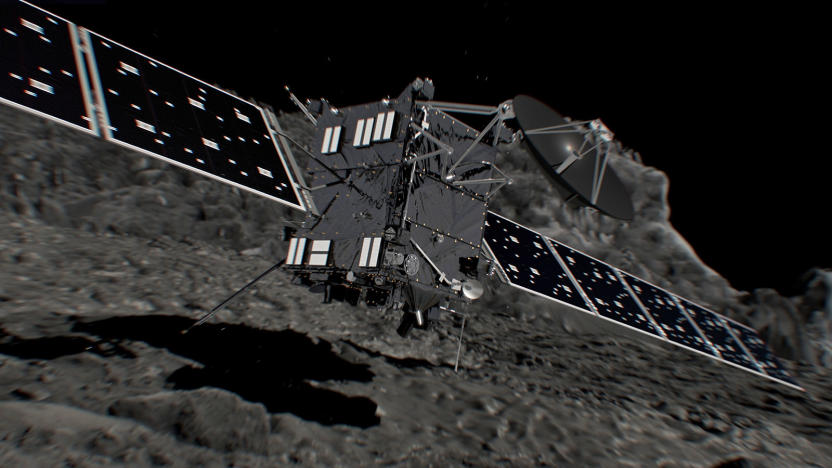
Watch the Rosetta probe fall into its death spiral this Friday
On September 30th, the European Space Agency's (ESA) Rosetta probe will cap off its 12-year career surveying Comet 67P (aka Churyumov-Gerasimenko) by slowly descending to its surface. There the spacecraft will join its lander Philae, given up for lost and recently re-found, before losing all power upon landing. You can watch Rosetta's last dance with its comet partner on NASA TV and elsewhere online, both broadcasting the probe's end with analysis and commentary on Friday from 6:15 AM until 8 AM ET.
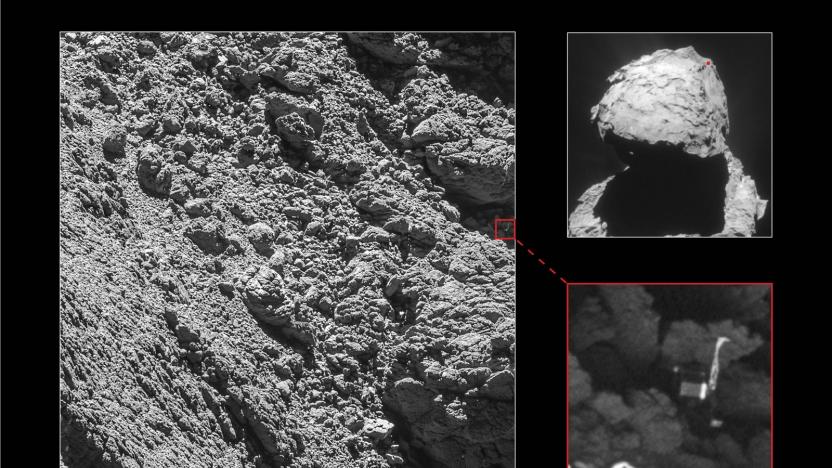
Rosetta probe belatedly finds the Philae comet lander
You have to sympathize with the European Space Agency. It's less than a month away from crashing its Rosetta probe into its host comet, and it just found the Philae comet lander -- you know, the machine the mission team stopped trying to contact back in July. Photos show that the lander get stuck in a dark crack on the comet in a position that prevents it from getting sunlight, revealing exactly why it went to sleep after a mere three days of activity. The ESA has had a general idea of where Philae was, but the low-resolution photos available before now made it hard to pinpoint the machine's location.
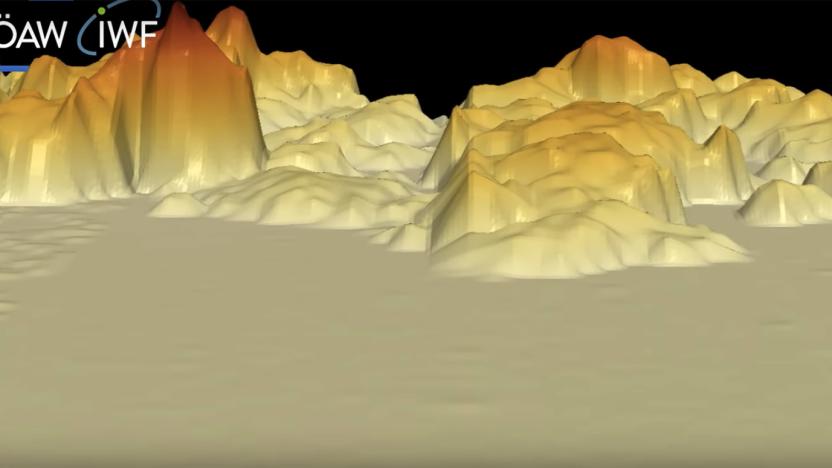
Rosetta 3D images comet dust before it bids farewell
Rosetta's scientists are doing every bit of science they can before the European Space Agency crashes the probe into the comet it's been studying. In fact, the spacecraft's Micro-Imaging Dust Analysis System (MIDAS) has just analyzed dust samples Rosetta collected from Comet 67P/Churyumov-Gerasimenko from November 2014 to February 2015. Mark Bentley, MIDAS' principal investigator, explained that "we need to understand the structure of the smallest grains and how they are built" to understand how comets are formed. Comet dust could also shed light on the beginnings of our solar system.
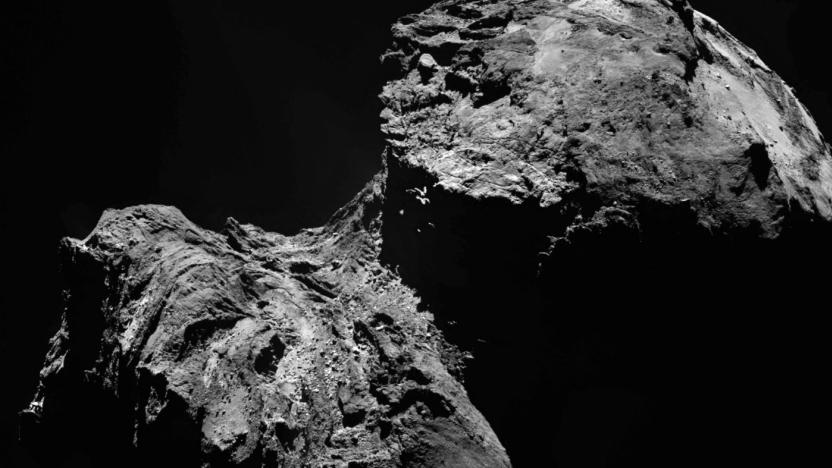
Rosetta will crash into its comet and die on September 30th
Farewell, young spacecraft. The European Space Agency's Rosetta probe has been surveying Comet 67P (or Churyumov-Gerasimenko) for the past 12 years, and on September 30th it will crash into the space rock and end its mission. Rosetta is nearing the orbit of Jupiter, which means it's running short on solar power and bandwidth required to downlink necessary data.

Scientists find a tailless comet from Earth's early days
It's well-established that the many asteroids and comets in the Solar System are the result of its violent early history, but finding an untouched example from the inner system is difficult. However, an astronomy team has discovered just that -- and it might shed a lot of light on our homeworld's early days. Thanks to both Pan-STARRS 1 and the Very Large Telescope, they've spotted a tailless, predominantly rocky comet (C/2014 S3) that has all the telltale signs of a "pristine" asteroid formed in the inner Solar System around the same time as the Earth, roughly 4.5 billion years ago. Its long, 860-year orbit hints that it was kicked towards the Oort Cloud (the system's extremely distant bubble of comets and other icy bodies) in the ancient past and only recently got pulled back toward the Sun.

Key ingredient of life might have come from comets
Life on Earth might not have developed as we know it without a little sprinkling of sugar from space. A new study by a group of French scientists suggests the possibility that early Earth got its first dose of the simple sugar ribose from comets. Ribose, as you might know, is an important ingredient in RNA, which is one of the three macromolecules essential for life.
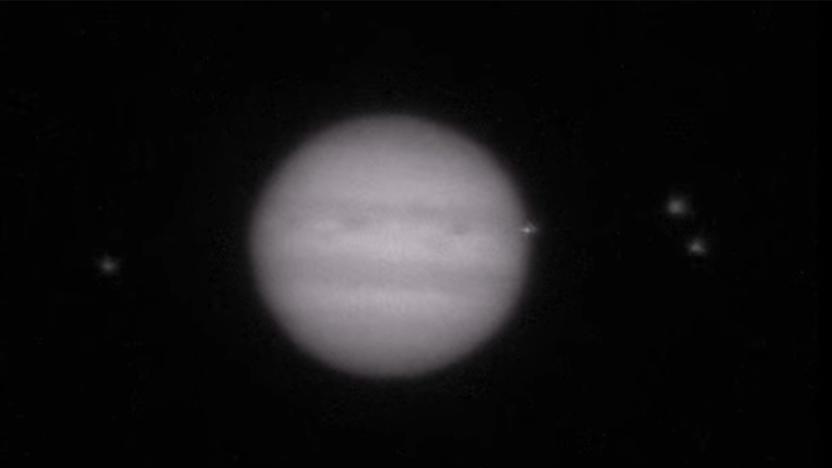
Amateur astronomers caught a Jupiter impact on camera
Jupiter gets hit by wayward celestial objects surprisingly often (about once per year), but you'd be forgiven if you didn't know it. Not all of them are visible, and professionals can only observe so much. However, the rise in readily accessible astronomy tech just helped detect one of these encounters. Amateur astronomers from Austria and Ireland have recorded videos showing that something, most likely an asteroid or comet, struck Jupiter on March 17th. The collision only lasted for a split second (blink and you'll miss it in the videos below) but it was ferocious -- even if the object was only a few hundred feet across, Jupiter's intense gravity guaranteed a high-velocity impact that would be visible from Earth.

Philae mission team says goodbye to the comet lander
The mostly quiet Philae comet lander appears to be silent for good. German space agency DLR announced today that it would no longer attempt to send commands to the unit. "Unfortunately, the probability of Philae re-establishing contact with our team at the DLR Lander Control Center is almost zero... it would be very surprising if we received a signal now," said project manager Stephan Ulamec. The news isn't too unexpected as the German Aerospace Center revealed last month that the latest attempts to revive the lander had been unsuccessful.

Philae comet lander has likely gone silent for good
If you were hoping for a happy ending to the Philae comet lander's frequently perilous adventures, you might be disappointed. The German Aerospace Center reports that a last-ditch attempt at contacting the lander has so far gone without a response. Either it doesn't have enough power to follow through, or it didn't get the commands in the first place. There will still be "contact opportunities" until January 21st (when the Rosetta spacecraft flies to the comet's southern hemisphere), the Center says, but it's not expecting to hear back.

That star's 'alien megastructure' is likely just a swarm of comets
Occam's Razor apparently holds true everywhere, even in the farthest reaches of space. While researchers speculated that star KIC 8462852's mysterious dimming might be the result of alien megastructures, NASA is about to publish evidence supporting the theory that it's really just a swarm of comets. Based on the strange dimming and the moderate infrared light levels, you may be looking at a pack of cold comets on a "very long, eccentric" orbit. If so, the strange signatures over the years reflect different-size comets passing around the star.








